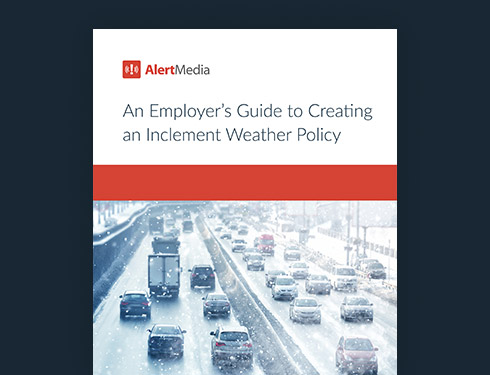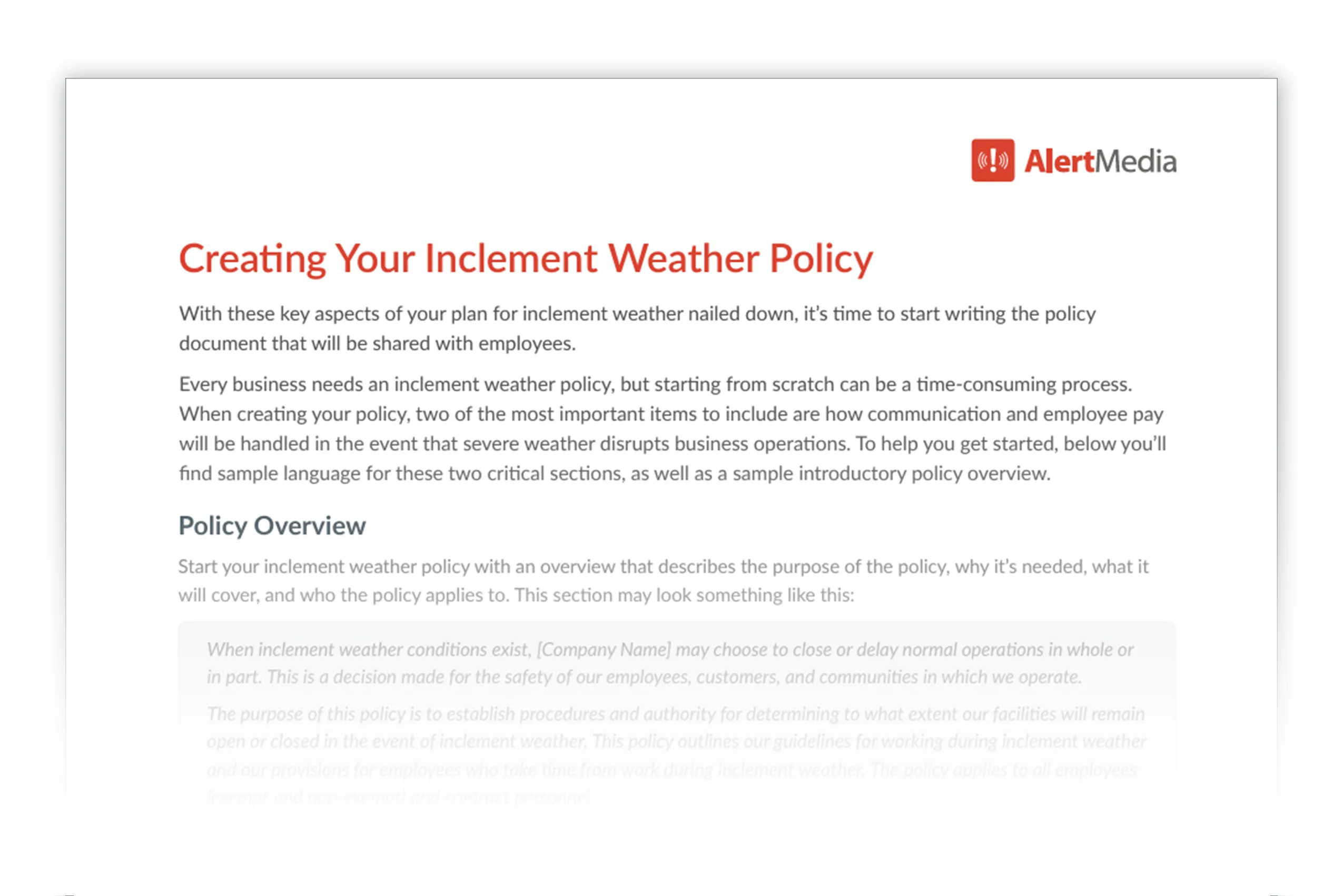
How to Create an Inclement Weather Policy: Guide & Template
Severe weather shouldn’t leave your team scrambling for answers. A well-defined inclement weather policy eliminates uncertainty—ensuring operational continuity, employee safety, and clear accountability.

For hundreds of years, humans have attempted to predict the weather, with varying levels of success, in an effort to minimize disruptions and plan ahead. As early as 650 B.C., the Babylonians tried forecasting near-term weather changes based on atmospheric conditions, such as clouds’ appearance. More than a millennium later, meteorologists can now accurately predict the weather five days in advance 90% of the time.
Yet, much about the severity of weather events—including the areas that will be most affected—is still unknown until they’ve arrived, making it all the more important to have a plan in advance.
AlertMedia’s Senior Meteorologist Jason Moreland explains further:
![]() “Severe thunderstorms and tornado outbreaks highlight this reality. Meteorologists can often identify days with heightened risk, but minor, hard-to-measure differences in the atmosphere still determine how many tornadoes form and which communities are affected.
“Severe thunderstorms and tornado outbreaks highlight this reality. Meteorologists can often identify days with heightened risk, but minor, hard-to-measure differences in the atmosphere still determine how many tornadoes form and which communities are affected.
“During active outbreaks, meteorologists monitor surface and upper-atmosphere data—including wind speed, temperature, and moisture—to track instability and storm development in real time. Radar, satellite, lightning, and trained spotters on the ground provide the best information for confirming dangerous conditions. Despite modern advances, we still don’t fully understand why some storms produce tornadoes and others don’t—and real-time reporting continues to outperform even the best computer models.”
Inclement weather, including hurricanes, floods, winter storms, natural disasters, and extreme heat, can disrupt business without warning. It often forces organizations to activate crisis management plans quickly to share accurate information with at-risk employees or make urgent changes to operations. Without a clear company policy about severe weather, sudden weather shifts can leave employees uncertain about whether, when, or how their work will be affected.
With an inclement weather policy, you can better prepare your organization for the next time bad weather threatens to disrupt normal business operations. It will also help you better protect your people and fulfill your organization’s duty of care.
In this blog post, we’ll explore how inclement weather may impact your business, why you need an inclement weather policy, and what it should cover.
Inclement Weather Policy Template
What Does Inclement Weather Mean?
Inclement weather is any severe or harsh weather condition that makes traveling, commuting, or working outdoors unsafe or impractical. And while the term “inclement weather” may bring visions of snow-packed streets and icy walkways to mind, it’s not just companies in cold climates that need an inclement weather policy.
All regions and businesses face weather-related threats and challenges. Snow, sleet, frigid temperatures, high temperatures, heavy rain, hurricanes, high winds, tornadoes, wildfires, and other hazardous conditions are just some inclement weather events your business may encounter.
Unremarkable weather in one region can also be considered inclement weather in another. For example, a light dusting of snow in Boston likely wouldn’t be enough to disrupt local travel, schools, and businesses. However, in Southern states, it can wreak havoc due to the lack of snowplows, de-icing equipment, driver experience, and general winter weather preparedness.
These weather events are also becoming more common, as Jason Moreland explains: “In 2024, the United States experienced 27 separate billion-dollar weather and climate disasters, just one shy of the record set in 2023. These events resulted in at least 568 fatalities and caused approximately $182.7 billion in damages, making 2024 the fourth-costliest year on record. As these long-term upward trends continue, more weather extremes are likely in the coming months and years.”
FAQs for Adverse Weather Policies
- How should we begin creating an inclement weather policy that addresses all types of extreme weather conditions? Start by identifying the specific weather risks your locations face throughout the year. Then define clear procedures for operations, communication, attendance, and safety. Involve HR, legal, facilities, and executive leadership to ensure it’s comprehensive and aligned with business continuity plans.
- How can we set consistent thresholds for activating the policy during events like natural disasters, weather-related closures, or a state of emergency? Use objective criteria where possible, such as local government-issued alerts or National Weather Service warnings, to trigger policy actions. Threat Intelligence software can also help you stay up to date on all the risks your business and people face.
- What roles do OSHA and NIOSH guidelines play in shaping an inclement weather policy? The Occupational Safety and Health Administration National Institute for Occupational Safety and Health both provide authoritative recommendations on workplace safety during extreme weather, especially for employees exposed to outdoor hazards or temperature extremes. Incorporating their guidance can help ensure your policy reflects best practices and meets your duty-of-care obligations.
- How can we tailor our policy to support both in-office and remote work teams during inclement weather? Clarify expectations for each group. For remote teams, provide guidelines on power outages, internet loss, and how to report availability. For in-office roles, specify when remote work is allowed or required during hazardous conditions.
- What’s the best way to handle communication about closures, schedule changes, or safety instructions during a weather disruption? Use a multichannel communication system to ensure fast, reliable delivery of updates. AlertMedia’s Mass Notification System helps you reach employees via text, phone, email, and more—even during power or internet outages.
- How should we define and communicate attendance expectations fairly when severe weather disrupts normal operations? Be clear in advance about when attendance is mandatory, optional, or prohibited. Consider regional differences, transportation access, and safety concerns. Avoid penalizing employees for staying safe.
- What should we include in the policy regarding power or internet loss affecting remote employees during storms? Explain how remote employees should report outages and document lost work time. If possible, allow flexibility or use PTO if connectivity issues prevent them from working safely or effectively.
- Are we required to offer natural disaster financial support to employees, or is it considered a voluntary benefit? There’s no legal obligation in most cases, but offering financial support like paid time off or hardship funds is a strong way to demonstrate your organization's commitment to employee well-being.
- How do we handle employee compensation for both exempt and nonexempt staff during closures, and what are our obligations under the Fair Labor Standards Act? Under the FLSA, exempt employees must be paid their full salary if they perform any work during a workweek. Nonexempt employees only need to be paid for hours worked, though you may allow PTO or other options for missed time.
What Does an Inclement Weather Policy Cover?
While severe weather is unpredictable, your company’s response shouldn’t be. A well-written inclement weather policy provides helpful details about your company’s procedures and helps to set appropriate expectations with employees about what to do when bad weather strikes. For example:
- Should employees venture into the office or work remotely if it’s snowing?
- If local authorities issue voluntary hurricane evacuation orders, do you expect employees to put in a full day?
- What steps should remote employees take if they lose power or their internet connection?
- How hot is too hot when working outdoors?
- How will employees be notified of closures or reduced work hours?
- Will nonexempt employees’ pay and benefits be affected if there are closings due to weather?
- Will there be any additional compensation adjustments for essential personnel required to work during inclement weather?
The middle of a significant snowstorm or just before a hurricane hits is not the time to start pondering these questions or how you’ll communicate this vital information to employees. Creating an inclement weather policy is a great way to ensure you have answers to questions like these.
Why Your Business Needs an Inclement Weather Policy
By eliminating ambiguity with an inclement weather policy, you can avoid confusion about whether an employee should report to work and how the organization handles employee pay and benefits. Defining policies and procedures for inclement weather before it happens also helps accelerate communication, increase productivity, and keep your business moving when juggling a multi-faceted emergency response plan.
When an employee braves dangerous winter driving conditions only to arrive at the office to find it closed, or they are told to stay home, and then find their next paycheck isn’t what they were expecting—communicating your policies after the fact is much too late.
How to Create an Inclement Weather Policy
Organizations have a duty of care: a legal and ethical responsibility to take reasonable steps to protect employees from harm while they’re working on the company’s behalf. This includes assessing weather-related risks and making informed decisions to keep staff safe during severe conditions. Even though duty of care doesn’t always extend to commuting, employers could face legal consequences if an employee is injured while traveling to work in unsafe weather. A well-crafted inclement weather policy helps fulfill this duty, minimize risk, and ensure the business can resume operations safely. Here are six steps to managing this:
- Determine your approach to business cancellations, closures, and delays
- Set up a reliable employee communication plan
- Establish your approach to employee pay and benefits
- Define expectations for remote work
- Tailor the policy to your industry and locations
- Review and update the policy regularly
1. Determine your approach to business cancellations, closures, and delays
Start by defining the specific weather conditions that could disrupt your operations. These might include winter storms, hurricanes, flash floods, or extreme temperatures. Identify who is responsible for monitoring weather alerts and making decisions within your organization. Be transparent about the process for declaring a business closure, late start, or early dismissal. If you operate across multiple locations, build flexibility for regional conditions.
You should also decide whether your organization will follow the lead of local governmental offices or set independent criteria. Some companies use school closures or emergency declarations as benchmarks. Others may rely on internal risk assessments, especially when employee travel or fieldwork is involved. Some questions you can ask when weighing the decision to close or delay operations might include:
- Are roads and public transportation routes safe and accessible?
- Have nearby schools, businesses, or government offices closed?
- Will operating as normal put employees or customers at risk?
- Do we have enough staff available to operate safely and effectively?
- Can essential functions be performed remotely?
- How long are the hazardous conditions expected to last?
- Are there employees who may be disproportionately impacted by the conditions?
- Does our existing leave or remote work policy apply in this situation?
- Have we communicated clearly with employees about the situation and expectations?
- Are our emergency communication systems ready to send timely updates?
- What impact would a delay or closure have on our customers or partners?
- Are we aligned with industry or regional practices for similar conditions?
- Is this the time to shift to a modified or reduced operations schedule?
2. Set up a reliable employee communication plan
Effective communication is the backbone of any inclement weather response. It ensures that all employees receive timely and accurate information, whether on-site, working remotely, or affected by local conditions such as power outages, school closures, or public transit disruptions. Without a structured plan in place, even small messaging delays can create confusion, increase labor costs, or compromise employee safety.
Your communication plan should clearly define the who, what, where, when, why, and how so that everyone, from frontline workers to board members, understands what to expect, how information will be delivered, and how they are expected to respond.
| Who should communicate? | What should be communicated? |
Clear communication starts with assigning the right people to speak on behalf of the organization. When you define roles in advance, messaging is faster, more consistent, and easier for employees to trust.
| Messages should deliver only the most relevant and actionable information. Employees need clear, concise updates that help them make immediate decisions about their workday.
|
| Where will the messages be sent? | When will you send notifications? |
The message must reach every employee, regardless of location or device access. Using multiple channels reduces the risk of missed updates during weather-related disruptions.
| Timing matters as much as the message itself. Employees need to hear from you early enough to adjust their plans safely and effectively.
|
| Why should employees listen? | How should employees respond? |
Employees are more likely to follow instructions and stay calm during weather-related disruptions when they understand the reason behind each decision. Communicating the why builds trust and reduces resistance.
| Employees need simple, actionable steps to follow after receiving a weather-related update. The policy should spell out what’s expected to avoid confusion and delays.
|
3. Establish your approach to employee pay and benefits
Handling payroll during a weather-related disruption can be complex, especially when it involves exempt and non-exempt employees. Your policy should clearly state whether hourly employees will be paid if they cannot work due to a closure. If not, will they be allowed to use paid time off or make up the time later? If your company offers a liberal leave policy, explain how it applies during inclement weather.
For exempt employees, follow the Fair Labor Standards Act (FLSA), which generally requires that salaried employees be paid their full wages for the week if they perform any work. If your business closes midweek and exempt staff have already worked, they must be fully compensated.
4. Define expectations for remote work
Remote work adds flexibility during weather disruptions but also creates potential for confusion. Your policy should clearly define when remote work is expected, what qualifies as a legitimate exception, and how employees should stay accountable when working off-site. Best practices for remote work suggest you:
- Specify that loss of power or internet must be reported if it lasts longer than two hours.
- Require employees to notify their manager within one hour of their scheduled start if they cannot work.
- Include a process for submitting a brief work log for remote days during weather events.
- Clarify whether missed work must be made up or covered by PTO.
- Establish daily check-ins for teams with ongoing deadlines or shift-based roles.
5. Tailor the policy to your industry and locations
Your policy should reflect the nature of your business and the regions you serve. For example, utility companies or energy providers may have different expectations for field staff than administrative employees. Outdoor workers may need temperature-specific guidelines, while office staff might follow standard closure procedures.
If your locations regularly experience hurricanes, wildfires, or ice storms, include relevant weather-specific procedures. Some organizations create separate sub-policies for high-risk weather events to provide greater clarity.
6. Review and update the policy regularly
An outdated policy can create more confusion than no policy at all. Review your inclement weather policy at least once a year or after any significant weather disruption. Ensure that contact lists are accurate, decision-making roles are assigned, and legal guidance is current.
Invite feedback from employees and managers who experienced recent weather events. Their input can help you identify gaps or clarify expectations for the next time severe weather hits.
Common Inclement Weather Scenarios
It’s not just snow and ice that can threaten employee safety and disrupt businesses. For some regions, inclement weather takes other forms: dangerously high winds, erratic wildfires, extreme heat, and cold temperatures. Inclement weather is a year-round concern. Regardless of where a company does business, it should have an inclement weather policy to address the weather-related hazards its people may experience.
As you assess the specific types of inclement weather your business and employees may face, consider the following:
Winter weather

Winter weather impacts almost every location in the United States. Even parts of Hawaii get snow. But the impact varies wildly by location. Locations in the North might face blizzards or snow-ins, but are generally more resilient to snowy weather. Locations in the South, by contrast, might not see much snow but could completely shut down with the slightest precipitation. Ensure your policy includes the most likely winter hazards your business will face.
Extreme heat
Workers can be exposed to dangerous, extreme heat both outdoors and indoors. Employers are required to protect employees from known hazards that could lead to harm, including heat stress, injury, and illness. Critical heat safety recommendations address hydration, rest breaks, cooling clothing, workload reduction, acclimatization, peer oversight to recognize signs of heat stress, and first aid training.
Hurricanes
If you have business locations on the Atlantic coast or near the Gulf of Mexico, hurricanes will likely impact them somehow. Hurricanes commonly bring severe and prolonged inclement weather, including strong winds, heavy rains, and flooding. Indirectly, hurricanes will cause food and gas shortages, impact travel, and disrupt supply chains. They can even cause massive displacement and forced evacuations. How will your business and its employees react to these challenges?
Heavy rains and flooding
Each year, 75% of weather-related vehicle crashes occur on wet pavement, and 47% happen during rainfall. Heavy rain and wet weather can make driving a white-knuckle experience, reducing vehicle traction, maneuverability, and visibility. Some businesses may also have hyper-local concerns, such as having offices in flood zones or near landslide-prone areas. In severe thunderstorms, lightning, hail, and flash floods can come on suddenly and be particularly dangerous for employees who must travel or work outdoors.
Tornadoes
Tornadoes can occur with little to no warning. For Midwest businesses that may find themselves on the path of a tornado, planning and ensuring everybody knows what to do when a tornado watch or tornado warning sounds are key. Tornadoes and high winds can threaten life and property, devastating entire communities in minutes. To prepare for a tornado, include details on when employees should take shelter, suitable shelter locations, and how all personnel will be accounted for in your written policy.
Inclement Weather Policy Samples
Every business needs an inclement weather policy, but starting from scratch can be daunting. To help, below you’ll find several free inclement weather policy templates and examples that you can tailor to your company’s needs.
Policy sample #1: Broad inclement weather policy
All companies need a clear, comprehensive inclement weather policy they can share to ensure employees are informed before a storm, heat wave, or other severe weather event occurs.
This sample inclement weather policy combines all the above recommendations into a comprehensive example tailored for a fictional petroleum company based in the Northeast.
Midland Petroleum Inclement Weather Policy
Effective Date: Jan. 2023
Last Reviewed: Jan. 2025
Policy Owner: Human Resources Department
1. Purpose
The purpose of this policy is to establish procedures and expectations for Midland Petroleum employees during inclement weather conditions to ensure safety, maintain essential operations, and comply with applicable laws and regulations.
2. Scope
This policy applies to all Midland Petroleum employees, including full-time, part-time, temporary, and contract workers, across all locations in the Northeast region.
3. Definition of inclement weather
Inclement weather includes, but is not limited to, severe snowstorms, ice storms, blizzards, hurricanes, flooding, extreme temperatures, and other natural disasters that may pose safety risks or disrupt normal business operations.
4. Policy Guidelines
4.1. Essential vs. Non-Essential Personnel
- Essential Personnel: Employees whose roles are critical to maintaining operations during inclement weather (e.g., field technicians, emergency response teams). These employees are expected to report to work unless otherwise directed.
- Non-Essential Personnel: Employees whose roles are not critical during inclement weather events. These employees may be advised to work remotely or may be excused from work based on the severity of the weather conditions.
4.2. Communication protocols
Midland Petroleum utilizes AlertMedia’s Emergency Mass Notification System to communicate with employees during emergencies. Notifications regarding office closures, delayed openings, or other weather-related updates will be sent via:
- Text messages
- Emails
- Phone calls
- Company intranet postings
Employees are responsible for ensuring their contact information is up to date in the company’s HR system.
4.3. Attendance expectations
- Employees are expected to make reasonable efforts to report to work during inclement weather.
- If unable to report to work, employees must notify their supervisor as soon as possible.
- Employees who are unable to work due to weather conditions may be required to use available paid time off (PTO) or may be granted unpaid leave, subject to managerial discretion.
4.4. Remote work
- Employees capable of performing their duties remotely may be instructed to work from home during inclement weather events.
- Remote work arrangements must be approved by the employee’s supervisor.
4.5. Compensation
- Exempt Employees: Will receive their regular salary regardless of office closures, in accordance with the Fair Labor Standards Act (FLSA).
- Non-Exempt Employees: Will be compensated for hours worked. If the office is closed and the employee is not working remotely, they may be required to use PTO or may be granted unpaid leave.
4.6. Safety during weather disruptions
- Employees are advised to prioritize personal safety during inclement weather.
- Employees should follow guidance from local authorities and the National Institute for Occupational Safety and Health (NIOSH) regarding safe practices during extreme weather conditions.
4.7. Natural disaster financial support
In the event of a declared state of emergency or natural disaster, Midland Petroleum may provide financial assistance to affected employees. Eligibility and the amount of assistance will be determined on a case-by-case basis.
5. Responsibilities
- Employees: Stay informed about weather conditions, maintain updated contact information, and communicate with supervisors regarding attendance and work capabilities.
- Supervisors: Assess operational needs, approve remote work arrangements, and communicate expectations to team members.
- Human Resources: Maintain and disseminate the inclement weather policy, coordinate with AlertMedia for communications, and provide support to employees as needed.
6. Policy review
This policy will be reviewed annually and updated as necessary to ensure compliance with legal requirements and alignment with best practices.
Policy sample #2: Location-specific policy
While a broad inclement weather policy outlines advance notice and general response plans, it offers limited guidance on execution. This more detailed example from Integrity HR focuses on the immediate needs of operational continuity and clear communication during weather disruptions. It states specifically what will happen and when. For example:
“[Company Name] makes a decision by 8:30 a.m. during periods of such inclement weather and communicates this to local media including [insert radio station and television station]. The company will also post the closure on the homepage of the website.”
Statements like these should be tailored to each location or worksite. They’re best suited for area-specific or operations-level policies that prioritize implementation over broad guidance.
Policy sample #3: Weather-specific policy
Regions that regularly experience severe weather, such as hurricanes in Florida and Texas or ice storms in New England, may implement separate, more-targeted policies to address those conditions.
One example is the AmTrust Financial Hurricane Preparedness Employee Guide, which outlines company expectations, safety measures, and communication protocols specifically for hurricane scenarios. This type of focused policy helps organizations respond more effectively to predictable, high-risk weather events.
You can also download our inclement weather policy guide to make creating your policy easier.
 Preview our guide for creating your own inclement weather policy.
Preview our guide for creating your own inclement weather policy.How to Communicate With Employees During Inclement Weather
Once you’ve created your business’s inclement weather policy, you’ll want to make sure it’s included in the employee handbook and that each employee receives a copy. By using emergency communication software, you can also rapidly reach any employee anywhere in the world with urgent, time-sensitive information as severe weather conditions arise.
New England-based Rockland Trust uses AlertMedia’s emergency notification software to reliably communicate with employees about winter storm-related outages and closures, even during inevitable power and internet outages.
On the West Coast, AlertMedia’s emergency communication system helps Kawasaki keep its people safe and connected during severe weather events that impact the region. When wildfires raged across Southern California, AlertMedia’s location tracking and geofencing capabilities made it easy for Kawasaki to identify and communicate with affected employees rapidly.
With a mass notification system, organizations can reach employees on any device through various channels. Organizations can ensure maximum deliverability by sending notifications about inclement weather across multiple channels—including text, phone calls, email, mobile apps, social media, and even desktop takeover. Two-way messaging lets employers stay in touch with employees, even in emergencies. And with event pages, you can ensure employees can always access the latest news and updates via a single online repository.
Other features of an emergency communication system that are particularly valuable during inclement weather include pre-built notification templates to expedite communication, real-time delivery performance statistics to confirm message delivery, and HRIS integration to ensure accurate contact information. The ability to quickly conduct employee wellness check surveys can also help you determine which employees may require assistance.
Here are a few examples of notification templates you can use to warn your employees about approaching inclement weather:
| Text message
Severe weather is approaching [LOCATION]. Stay tuned for storm-related information, including potential office closures. Check your email for more details. |
| Email
[NAME OF CITY] will be impacted by the approaching inclement weather event. We will provide updates about office closures, road conditions, and additional resources by [INSERT MESSAGE ABOUT WHEN YOU’LL MAKE DECISIONS].
Reply to this message if the storm impacts your home or family and you need assistance. Please take home your computers/chargers and any other items necessary to complete your job remotely in case of office closures.
Contact your supervisor with any questions or concerns about the storm or our inclement weather policy. |
Finally, choosing a system with global threat intelligence capabilities enables your organization to take a more proactive approach to extreme weather. It does this by monitoring severe weather developments worldwide, assessing the potential impact, and automatically alerting employees who may be affected based on real-time location data.
Why Preparation Is Key to Inclement-Weather Readiness
These infamous words are etched in granite over the entrance to the New York City Post Office on 8th Avenue: “Neither snow nor rain nor heat nor gloom of night stays these couriers from the swift completion of their appointed rounds.” And while this noble sentiment might have motivated postal carriers long ago, today’s workers have other guidance.
Today, every organization needs an inclement weather policy. Creating one protects employees and the business. By having a solid policy in place and the means to communicate with employees, you’ll ensure they stay safe, connected, and informed during any extreme weather conditions that may arise.




